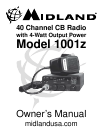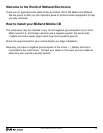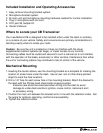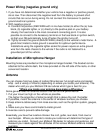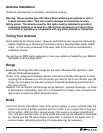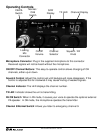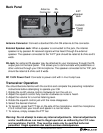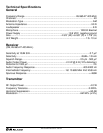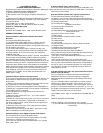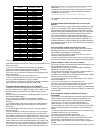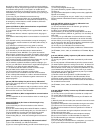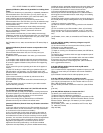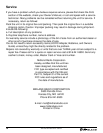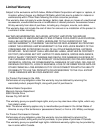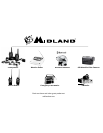
Channel
Frequency
(megahertz - MHz)
1 26.965
2 26.975
3 26.985
4 27.005
5 27.015
6 27.025
7 27.035
8 27.055
9
1
27.065
10 27.075
11 27.085
12 27.105
13 27.115
14 27.125
15 27.135
16 27.155
17 27.165
18 27.175
19 27.185
20 27.205
21 27.215
22 27.225
23 27.255
24 27.235
25 27.245
26 27.265
27 27.275
28 27.285
29 27.295
30 27.305
31 27.315
32 27.325
33 27.335
34 27.345
35 27.355
36 27.365
37 27.375
38 27.385
39 27.395
40 27.405
1
See paragraph (b) of this section
(b) Channel 9 may be used only for emergency communications or for
traveler assistance.
(c) You must, at all times and on all channels, give priority to
emergency communication messages concerning the immediate
safety of life or the immediate protection of property.
(d) You may use any channel for emergency communications or for
traveler assistance.
(e) You must share each channel with other users.
(f) The FCC will not assign any channel for the private or exclusive
use of any particular CB station or group of stations.
(g) The FCC will not assign any channel for the private or exclusive
use of CB stations transmitting single side-band or AM.
§ 95.408 (CB Rule 8) How high may I put my antenna?
(a) Antenna means the radiating system (for transmitting, receiving
or both) and the structure holding it up (tower, pole or mast). It also
means everything else attached to the radiating system and the
structure.
(b) If your antenna is mounted on a handheld portable unit, none of
the following limitations apply.
(c) If your antenna is installed at a xed location, it (whether
receiving, transmitting or both) must comply with either one of the
following:
(1) The highest point must not be more than 6.10 meters (20 feet)
higher than the highest point of the building or tree on which it is
mounted; or
(2) The highest point must not be more than 18.3 meters (60 feet)
above the ground.
(d) If your CB station is located near an airport, and if you antenna
structure is more than 6.1 meters (20 feet) high, you may have to
obey additional restrictions. The highest point of your antenna must
not exceed one meter above the airport elevation for every hundred
meters of distance from the nearest point of the nearest airport
runway. Differences in ground elevation between your antenna and
the airport runway may complicate this formula. If your CB station is
near an airport, you may contact the nearest FCC eld ofce for a
worksheet to help you gure the maximum allowable height of your
antenna. Consult part 17 of the FCC’s Rules for more information.
WARNING:———————————————————
Installation and removal of CB station antennas near power lines
is dangerous. For your safety, follow the installation directions
included with your antenna.
————————————————————————
[48 FR 24894, June 3, 1983, as amended at 48 FR 41416, Sept.
15, 1983]
§ 95.409 (CB Rule 9) What equipment may I use at my CB
station?
(a) You must use an FCC type-accepted CB transmitter at your CB
station. You can identify an FCC type-accepted transmitter by the
type-acceptance label placed on it by the manufacturer. You may
examine a list of type-accepted equipment at any FCC Field Ofce
or at FCC Headquarters. Use of a transmitter which is not FCC
type-accepted voids your authority to operate the station.
(b) You must not make, or have made, any internal modication to
a typeaccepted CB transmitter. (See CB Rule 25, §95.425). Any
internal modication to a type-accepted CB transmitter cancels the
type-acceptance, and use of such a transmitter voids your authority
to operate the station.
§ 95.410 (CB Rule 10) How much power may I use?
(a) Your CB station transmitter power output must not exceed the
following values under any conditions: AM (A3)—4 watts (carrier
power) SSB—12 watts (peak envelope power)
(b) If you need more information about the power rule, see the
technical rules in subpart E of part 95.
(c) Use of a transmitter which has carrier or peak envelope power in
excess of that authorized voids your authority to operate the station.
§ 95.411 (CB Rule 11) May I use power ampliers?
(a) You may not attach the following items (power ampliers) to your
typeaccepted CB transmitter in any way:
(1) External radio frequency (RF) power ampliers (sometimes
called linears or linear ampliers); or
(2) Any other devices which, when used with a radio transmitter as
a signal source, are capable of amplifying the signal.
(b) There are no exceptions to this rule and use of a power amplier
voids your authority to operate the station.
(c) The FCC will presume you have used a linear or other external
RF power amplier if—
(1) It is in your possession or on your premises; and
(2) There is other evidence that you have operated your CB station
with more power than allowed by CB Rule 10, § 95.410.
(d) Paragraph (c) of this section does not apply if you hold a license
in another radio service which allows you to operate an external RF
power amplier.
§ 95.412 (CB Rule 12) What communications may be
transmitted?
(a) You may use your CB station to transmit two-way plain language
communications. Two-way plain language communications are
communications without codes or coded messages. Operating
signals such as ‘‘ten codes’’ are not considered codes or
coded messages. You may transmit two-way plain language
communications only to other CB stations, to units of your own CB
station or to authorized government stations on CB frequencies
about—
(1) Your personal or business activities or those of members of your
immediate family living in your household;
(2) Emergencies (see CB Rule 18, § 95.418)
(3) Traveler assistance (see CB Rule 18, § 95.418); or
(4) Civil defense activities in connection with ofcial tests or drills
conducted by, or actual emergencies announced by, the civil
defense agency with authority over the area in which your station is
located.
(b) You may use your CB station to transmit a tone signal only when



